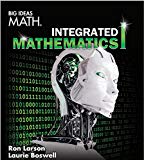
Concept explainers
a.
To find:Length of vacation each resort cost the same.
a.
Answer to Problem 24E
Length of vacation does each resort cost about the same =
Explanation of Solution
Given:
The room expenses for two different resorts given.
Concept Used:
Use patterns between consecutive data pairs to determine type of function. Linear function: - The difference of consecutive y-values is constant. Exponential function: - Consecutive y-values have a common ratio. In each case, the differences of consecutive x-values need to be constant.
Calculation:
Linear function: - The difference of consecutive y-values is constant. Exponential function: - Consecutive y-values have a common ratio. In each case, the differences of consecutive x-values need to be constant.
Picture given: -

Length of vacation does each resort cost about the same =
Hence,
Length of vacation does each resort cost about the same =
b.
To find:Whether sea breeze resort more expensive than blue water resort.
b.
Answer to Problem 24E
Yes, because the cost at Sea Breeze Resort shows exponential growth, it will eventually be greater than the cost at Blue Water Resort, which shows linear growth.
Explanation of Solution
Given:
The room expenses for two different resorts given.
Concept Used:
Use patterns between consecutive data pairs to determine type of function. Linear function: - The difference of consecutive y-values is constant. Exponential function: - Consecutive y-values have a common ratio. In each case, the differences of consecutive x-values need to be constant.
Calculation:
Linear function: - The difference of consecutive y-values is constant. Exponential function: - Consecutive y-values have a common ratio. In each case, the differences of consecutive x-values need to be constant.
Picture given: -

Blue water resort charges
Hence,
Yes, because the cost at Sea Breeze Resort shows exponential growth, it will eventually be greater than the cost at Blue Water Resort, which shows linear growth.
c.
To find:Blue water resort ever be more expensive than sea breeze resort.
c.
Answer to Problem 24E
The total cost is always greater at Sea Breeze Resort.
Explanation of Solution
Given:
The room expenses for two different resorts given.
Concept Used:
Use patterns between consecutive data pairs to determine type of function. Linear function: - The difference of consecutive y-values is constant. Exponential function: - Consecutive y-values have a common ratio. In each case, the differences of consecutive x-values need to be constant.
Calculation:
Linear function: - The difference of consecutive y-values is constant. Exponential function: - Consecutive y-values have a common ratio. In each case, the differences of consecutive x-values need to be constant.
Picture given: -

Sea Breeze resort charges
No, the cost of the first three nights is greater at Sea Breeze Resort than at Blue Water Resort. Also, the cost of each additional night at Sea Breeze Resort is greater than the cost of each additional night at Blue Water Resort.
Hence,
The total cost is always greater at Sea Breeze Resort.
Chapter 6 Solutions
BIG IDEAS MATH Integrated Math 1: Student Edition 2016
- The managing director of a consulting group has the accompanying monthly data on total overhead costs and professional labor hours to bill to clients. Complete parts a through c Overhead Costs Billable Hours345000 3000385000 4000410000 5000462000 6000530000 7000545000 8000arrow_forwardUsing the accompanying Home Market Value data and associated regression line, Market ValueMarket Valueequals=$28,416plus+$37.066×Square Feet, compute the errors associated with each observation using the formula e Subscript ieiequals=Upper Y Subscript iYiminus−ModifyingAbove Upper Y with caret Subscript iYi and construct a frequency distribution and histogram. Square Feet Market Value1813 911001916 1043001842 934001814 909001836 1020002030 1085001731 877001852 960001793 893001665 884001852 1009001619 967001690 876002370 1139002373 1131001666 875002122 1161001619 946001729 863001667 871001522 833001484 798001589 814001600 871001484 825001483 787001522 877001703 942001485 820001468 881001519 882001518 885001483 765001522 844001668 909001587 810001782 912001483 812001519 1007001522 872001684 966001581 86200arrow_forwardPatterns in Floor Tiling A square floor is to be tiled with square tiles as shown. There are blue tiles on the main diagonals and red tiles everywhere else. In all cases, both blue and red tiles must be used. and the two diagonals must have a common blue tile at the center of the floor. If 81 blue tiles will be used, how many red tiles will be needed?arrow_forward
- At a BBQ, you can choose to eat a burger, hotdog or pizza. you can choose to drink water, juice or pop. If you choose your meal at random, what is the probability that you will choose juice and a hot dog? What is the probability that you will not choose a burger and choose either water or pop?arrow_forwarda card is drawn from a standard deck of 52 cards. If a card is choosen at random, what is the probability that the card is a)heart b)a face card or c)a spade or 10arrow_forwardin a coffee shop, 160 customers came in. Of these, 60 bought coffe and cake and the rest ordered just coffee. determine the probability that the next person will buy coffee and cakearrow_forward
- Two dice are rolled and their sum calculated. Draw a table to show all of the possibilities. Determine the theoretical probability of rolling a sum of 7. And determine the theoretical probability of rolling a sum greater than 9arrow_forwarda. Find the value of A.b. Find pX(x) and py(y).c. Find pX|y(x|y) and py|X(y|x)d. Are x and y independent? Why or why not?arrow_forwardA football player makes 350 out of every 400 passes he throws. In a game he usually throws 26 passes. Estimate how many of these passes will be successfularrow_forward
- The PDF of an amplitude X of a Gaussian signal x(t) is given by:arrow_forwardThe PDF of a random variable X is given by the equation in the picture.arrow_forwardI forgot to mention to you to solve question 1 and 2. Can you solve it using all data that given in the pict i given and can you teach me about that.arrow_forward
 Discrete Mathematics and Its Applications ( 8th I...MathISBN:9781259676512Author:Kenneth H RosenPublisher:McGraw-Hill Education
Discrete Mathematics and Its Applications ( 8th I...MathISBN:9781259676512Author:Kenneth H RosenPublisher:McGraw-Hill Education Mathematics for Elementary Teachers with Activiti...MathISBN:9780134392790Author:Beckmann, SybillaPublisher:PEARSON
Mathematics for Elementary Teachers with Activiti...MathISBN:9780134392790Author:Beckmann, SybillaPublisher:PEARSON
 Thinking Mathematically (7th Edition)MathISBN:9780134683713Author:Robert F. BlitzerPublisher:PEARSON
Thinking Mathematically (7th Edition)MathISBN:9780134683713Author:Robert F. BlitzerPublisher:PEARSON Discrete Mathematics With ApplicationsMathISBN:9781337694193Author:EPP, Susanna S.Publisher:Cengage Learning,
Discrete Mathematics With ApplicationsMathISBN:9781337694193Author:EPP, Susanna S.Publisher:Cengage Learning, Pathways To Math Literacy (looseleaf)MathISBN:9781259985607Author:David Sobecki Professor, Brian A. MercerPublisher:McGraw-Hill Education
Pathways To Math Literacy (looseleaf)MathISBN:9781259985607Author:David Sobecki Professor, Brian A. MercerPublisher:McGraw-Hill Education





